Ancient Spartan Women – The Backbone of the Warrior State

In learning about Ancient Sparta, most of what is discussed is the lives of the men. Such as the fact that Spartan boys left home at the age of seven to be raised by the State in the agoge (the rigorous education program for all Spartan men). But as the cliche goes, behind every great man is a great woman. And it cannot be ignored that the strong Spartan women were the backbone of the warrior state.
Women in Sparta enjoyed a great deal more rights than their sisters in other Greek territories. They could own property, intermingle with the opposite sex, get an education, exercise and some even competed in the Olympic games (a thing forbidden to most women in Greece).
The elevated status of Spartan women was no accident though. Sparta at its very core was a military state, and just as laws were put in place to ensure the health and fitness of the men, there were also laws that encouraged strength and health of the women. After all, the Spartans believed that strong women produced strong sons and warriors.
SPARTA’S FOCUS ON CULTIVATING WARRIOR CITIZENS
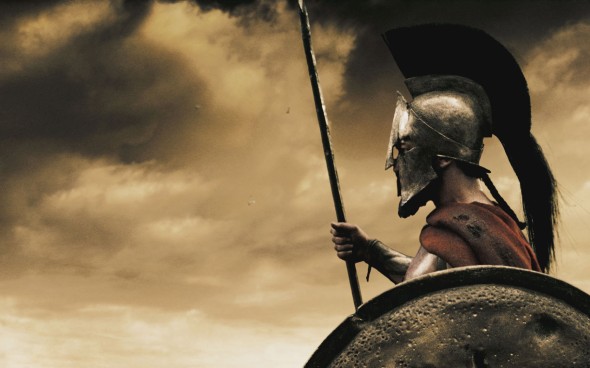
In reading this article, you must disillusion yourself with most of what you learned in the 300 movies. While entertaining, a large part of the movie was completely inaccurate. Sparta was not some model democracy with warriors fighting for freedom. Sparta was a totalitarian, military society where the state ruled almost every aspect of life. And a vast majority of the people living in Sparta were slaves.
By 600 BCE Sparta had conquered her neighbors in the southern half of the Peloponnese. These conquered people were called “Helots,” and forced to do all the agricultural work on land owned by the victors. This made Sparta a self sufficient state, leaving the citizens with more time for physical fitness and training for war. Yet Sparta was a brutal state that depended upon the oppression of the very large slave population to thrive. For every Spartan, there were eight helots.
Not needing to import anything, Sparta isolated itself from the culture of the rest of the world. But they feared the prospect of revolt from their huge slave population, and thus the country became an armed camp.
In order to survive, the state had to ensure that every one Spartan was strong enough to defeat at least eight helots. To that end, Spartans learned from an early age discipline, hardship, and the skills of a soldier. As part of their upbringing, Spartan youths were encouraged to go out into the countryside and kill helots who looked like they might become community leaders.
Since boys left home at an early age, and husbands and fathers spent a great part of their time in military training with other men, the women had much more time and autonomy to themselves than other women in Greece.
YOUTH AND TRAINING FOR LIFE
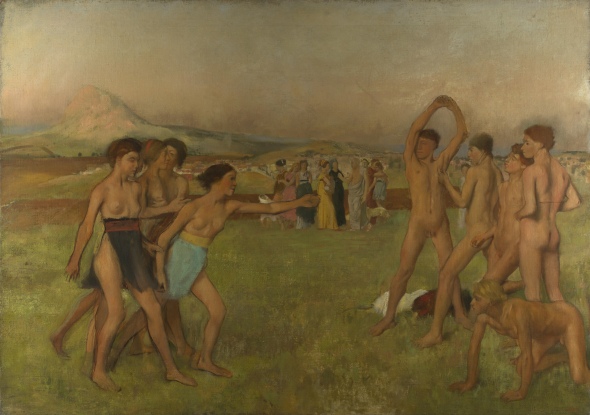
Young Spartans Exercising, From The National Gallery of London
According to Plutarch’s testimony, Spartans practiced infanticide in order to weed unhealthy children out of their society [1]. If a baby was weak, the Spartans would leave it on a hillside, or it was taken away to become a slave (helot). Infanticide was actually common in most societies up until today, but the Spartans were particularly picky. And it wasn’t just a family matter. The state decided the fate of the child. However, it is unclear whether this practice of infanticide applied just to boys, or boys and girls.
One thing that made Sparta unique among the Greek city-states is that the girl babies were just as well fed as their male counterparts. In Athens, the boys were fed better than the girls. But in Sparta, the strength of women as well as men was of vital importance to the state. So it was encouraged to feed girls enough for them to become big and strong. [2]
While boys were sent away to the agoge at the age of seven, it is believed that girls stayed home with their mothers. However, according to the writings of Pomeroy, there was some institutionalized education for girls. Girls were educated on and off through different periods of Spartan history. During the Hellenistic period it stopped, and under the Romans it was restored.[3]
Literacy was a skill limited to the elite. Though there is evidence from the classical period that women wrote letters to their sons while they were away in battle. [4] Women also studied what was called mousike – which was not just music, but dance and poetry [5]. There are surviving statues from the period showing women playing musical instruments.
The spartan exercise regimen for girls was to make them every bit as fit as their brothers. Spartan girls learned how to ride on horseback. Other events for girls included running, wrestling, throwing the discus, and “trials of strength” [6]. It is also possible that girls exercised in the nude in public, just like the men. After all, there is archaic Spartan art that shows girls exercising naked, while this was only true for men in Athens. Women also competed in various festivals, the most prestigious of which was the Heraean Games.[7]
MARRIAGE AND SEX
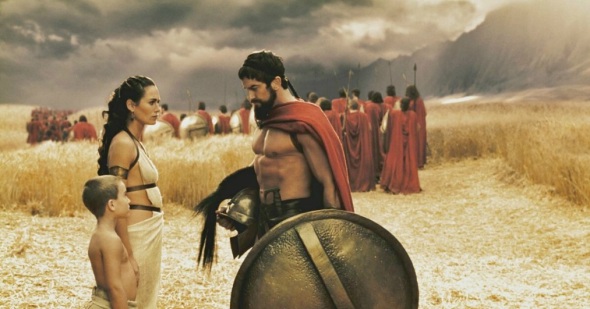
While I have discussed the freedoms of Spartan women above, it seems likely that Spartan marriages were arranged by the parents with little thought of the preferences of the perspective bride and groom. Yet aside from this detail, women still had more freedom in marriage and sex than most Greek women.
SPARTAN GIRLS MARRIED LATE
The average age of marriage for a Spartan woman was 18. While for other Greek women, the age was around their early teens. Some Spartan women even got married in their early to mid twenties (which was considered very late in the ancient world considering that people didn’t live very long). Because of this, Spartan women were much more mature when they got married, and were more likely to have a greater deal of control over their marriages than women who got married at a younger age.
Spartan women also typically married men who were closer to them in age. Men in their mid twenties or thirties. This might not seem that close in age to us modern folk today. But in the ancient Greek world, it was normal for a 30 year old man to marry a 14 year old girl. This was done so that women had the maximum amount of their breeding years to produce babies. But since the health and strength of the child was a bigger priority in Sparta than the number of children, getting married later made more sense. It is well known today that a woman will have a healthier child in her late teens and twenties, than her early teens, because she has been given more time to finish developing.
Yet despite all their relative freedoms, women in Sparta were still treated like breeding machines by the state. It is said that only a man who died in battle and a woman who died in childbirth would get their names inscribed on their tombstones. [8][9]
FEMALE POWER IN MARRIAGE

(Image Source)
Many Greeks in other lands thought that Spartan women had too much control over their husbands. Plutarch wrote that “the men of Sparta always obeyed their wives.” Aristotle was even more critical of the influence women had in politics arguing that it was contributing to the downfall of the country. Women did not have a vote in the assembly but seem to have had a lot of influence behind the scene.
ATYPICAL MARRIAGE CUSTOMS
Marriage among the Spartans was different from the rest of Greeks for many reasons. For one, it seemed that there was a great effort to get rid of the practice of giving a dowry. Some say this is because the Spartan state wanted couples to create children on the basis of health and strength, instead of money.
Married life for Spartans was also unique in that it was normal for the husband to spend a good deal of time away from his wife. Men were encouraged to live at the barracks until their 30’s. Until then, husbands and wives could only meet with one another in secret. Also, even in his 30’s, a man would still spend a great deal of time eating and training at the barracks – instead of eating home cooked meals. One outsider who ate with the Spartans at the barracks remarked, “Now I know why Spartan’s don’t fear death.”
A MOST UNUSUAL WEDDING RITUAL
On the night of the wedding, the bride would have her hair cut short, be dressed in a man’s cloak and sandals before being left alone in a dark room, where they would be visited and ritually “captured” by their new husband. Married women were forbidden from wearing their hair long. [10]
I guess after being around dudes forever, you have to make the transition to females go easier somehow.
WOMEN AND THEIR MULTIPLE LOVERS

In terms of other interesting sexual practices, some historians suggest that the Spartans engaged in polyandry: a practice where women were allowed to have sex with multiple male lovers. It is said that this was permissible because the state was the backbone of social life, not the family. Because of this, it is suggested that the identity of a child’s father was less important than it was in other cultures. Books like Sex Before Dawn even say that polyandry was a normal set up in many tribal cultures, where property was shared, rather than inherited along patrilineal lines. Since Sparta was a military state where property was divided and provided by the state, rather than familial inheritance, strength and health was the focus of sex and childbearing – not marriage and family.
Herodotus says that the bigamy of Anaxandridas II was un-Spartan (Herodotus, Histories, V.40.2) but Polybius wrote that it was common at his time, and a time-honoured practice.(Polybius XII.6b.8) Along with plural marriage, older men seem to have allowed younger, more fit men, to impregnate their wives. Other unmarried or childless men might even request another man’s wife to bear his children if she had previously been a strong child bearer. [11]
DIVORCE
Women were allowed to divorce with little consequences. They did not need to fear losing their home and property, because they lived among the community as equal citizens. They were also not discouraged from remarrying. A Spartan woman was also not forced to relinquish her children, because the identity of the child’s biological father was not vitally important.
MATRIARCHAL DUTIES
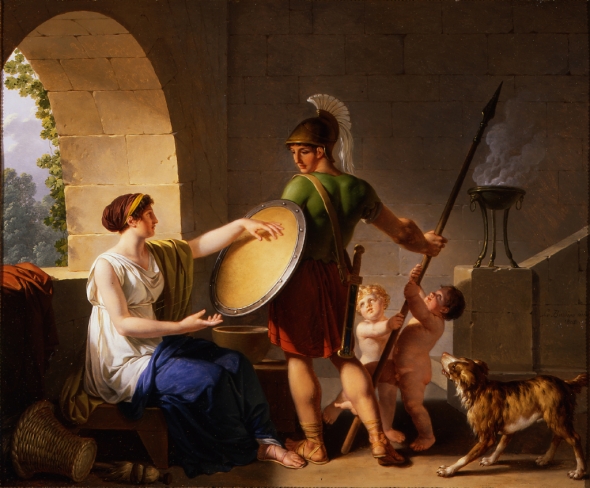
Because men spent so much time off at war, or training in the barracks, women were masters of the home. This is why women had social and political power in their communities. Due to this Aristotle was critical of Sparta, claiming that men were ruled by women there, unlike in the rest of Greece. Aristotle, Politics 1269b.
Aristotle also criticized Spartan women for their wealth. He attributed the state’s precipitous fall during his lifetime, from being the master of Greece to a second-rate power in less than 50 years, to the fact that Sparta had become a gynocracy whose women were intemperate and loved luxury. Aristotle, Politics 1269b–1270a.
All Spartan women took advantage of helot labor, so they did not have to spend their time doing the tedious work that most domestic Greek women performed. Therefore, the Spartan women had more time to participate in matters such as governance, agriculture, logistics, fitness, art, music, etc.
But they also spent a lot of time bearing and raising children. Bearing and raising children was considered the most important role for women in Spartan society, equal to male warrior in the Spartan army.
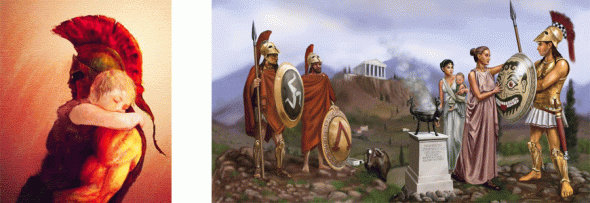
Also, despite the many glowing freedoms of Spartan women compared to women in other provinces, the state still preferred male babies in order to create a large and powerful military force. So women took pride in the warrior sons they birthed and raised. Having a son who died valiantly in battle was a source of great pride for a mother. By contrast however, having a son who was a coward was a source of great despair. The ancient author Aelian claims that women whose sons died as cowards lamented this [12]. By contrast, the female relatives of the Spartans who died heroically in the Battle of Leuctra were said to have walked around in public looking happy. [13]
When a warrior left for battle his mother would say, “Come home with your shield or upon it.”
RELIGION
The cults for women in ancient Sparta reflected society’s emphasis on their role as child-bearers and raisers. Consequently, cults focused on fertility, health and beauty. I will elaborate on the cults below.
THE CULT EILEITHYIA
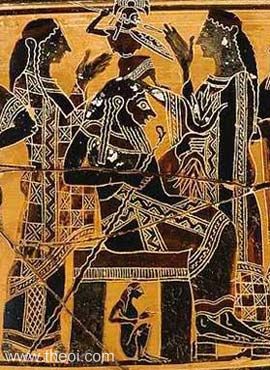
(Eleithyiae, Zeus & the birth of Athena | Athenian black-figure kothos C6th B.C.)
Eileithyia was the goddess of childbirth and midwifery. Some say there is a link between this Goddess and early Minoan culture. 19th-century scholars suggested that her name is Greek, from the verb eleutho (ἐλεύθω), “to bring,” the goddess thus being The Bringer.
In the Illiad she is described as following:
- And even as when the sharp dart striketh a woman in travail, [270] the piercing dart that the Eilithyiae, the goddesses of childbirth, send—even the daughters of Hera that have in their keeping bitter pangs;
- —Iliad 11.269–272
THE CULT OF HELEN
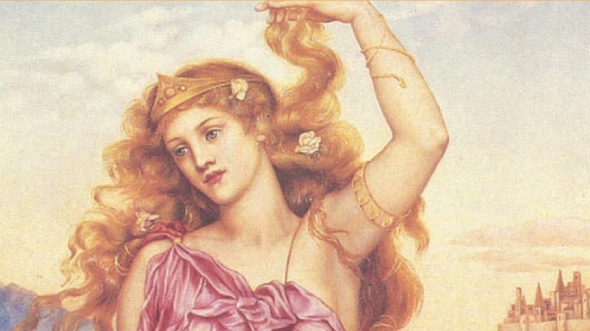
Most people are familiar with the story about Helen of Troy. The face that launched a thousand ships and all that. But much to my surprise upon researching this subject, she was also worshiped in some places as a Goddess. She had a festival at Laconia, the principle region of the Spartan state. (In fact the word “laconic” is derived from laconia, because the Spartans were known to speak in a concise, and to the point manner.) In the cult of Helen, women used objects such as mirrors, eye-liners, combs, and perfume bottles.
FAMOUS WOMEN IN SPARTA
QUEEN GORGO
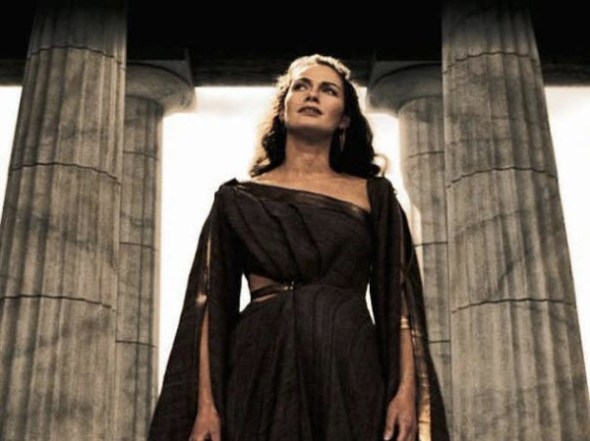
Because of the 300 movies, she is probably the first Spartan woman that most people today are familiar with. She was the wife of King Leonidas I, Cleomenes’ half-brother, who fought and died in the Battle of Thermopylae (that famous battle with Persian King Xerxes) you know..the bald guy in gold underwear who supposedly sounds like a androgynous robot. (Scene in 300 where he becomes a God).
But anyways, Gorgo is one of the few female figures actually named by the Greek historian Herodotus, and was well-known for her political judgment and wisdom.
Arguably, Gorgo’s most significant role occurred prior to the Persian invasion of 480 BC. According to Herodotus’s Histories, Demaratus, then in exile at the Persian court, sent a warning to Sparta about Xerxes’s pending invasion. In order to prevent the message from being intercepted by the Persians or their vassal states, the message was written on a wooden tablet and then covered with wax. The Spartans did not know what to do with the seemingly blank wax-tablet once they received it. Only Queen Gorgo figured out the puzzle. She advised them to clear the wax off the tablet and thus found the secret message. (“Herodotus ”History” [Translated into English]”. Ancienthistory.about.com. 2010-06-15. Retrieved 2011-07-24.)
ARACHIDAMIA

She was also a Spartan queen. She is most notable for her role in leading Spartan women against Pyrrhus during his siege of Lacedaemon in the 3rd century BC. In the face of the siege, the Spartan council of elders wanted to send the Spartan women off the Crete for their safety. But Arachidamia refused that offer. She entered the council with sword in hand, and contested this proposal, questioning whether the Spartan women were expected to survive the ruin of their own city. (Plutarch, Parallel Lives: Life of Pyrrhus § 27.2)
Instead she led the women into the battle effort. The women helped build a defensive trench, supplied the troops with defensive weapons, refreshment and took care of the wounded.
CYNISCA
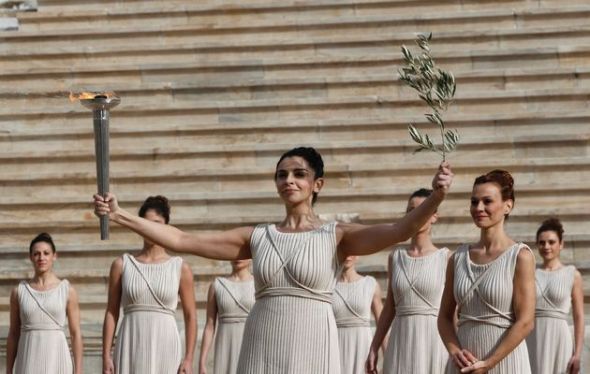
Cynisca was a Spartan princess and the first woman to win an Olympic victory. She also had a cult in Sparta.
IN SUMMARY
While much of history has concentrated on the role of Spartan men, it cannot be ignored that the Spartan women were a vital part of the warrior society. They raised warriors, and were brave leaders in their communities. They encouraged the men to be brave in battle, while also knowing how to take care of themselves and hold their own.
Life in the Spartan state was very difficult and harsh. So it took a harsh and strong woman, to raise a fierce society.
LINKS ON SPARTA
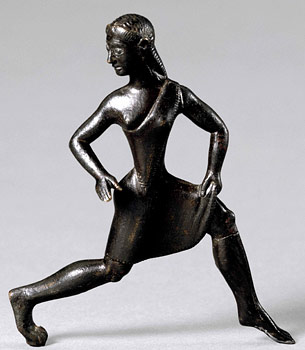
8 Reasons It Wasn’t Easy Being Spartan
Women in Sparta (on Wikipedia)
Social and Political Roles of Women in Athens and Sparta
SCANDALOUS” SPARTAN WOMEN:
EDUCATED AND ECONOMICALLY EMPOWERED
RELATED METAL GAIA ARTICLES
Ancient Egyptian Women – Marriage, Sexuality and Goddesses
LONG BORING LIST OF FOOTNOTES
[1] Pomeroy 2002, pp. 34–35
[2] Pomeroy 1994, p. 36
[3] Pomeroy 2002, pp. 27–28
[4] Pomeroy 2002, p. 8.
[5] Pomeroy 2002, p. 5
[6] Hughes 2005, p. 59
[7] Pomeroy 2002, p. 24
[8](Plutarch, Life of Lycurgus, 27.3)
[9](Dillon 2007, p. 151).
[10] Cartledge 1981, p. 101
[11] Powell 2001, p. 248.
[12] Pomeroy 2002, p. 58
[13] Pomeroy 2002, p. 58.
Pomeroy, Sarah B. (1994), Goddesses, Whores, Wives and Slaves: Women
in Classical Antiquity, London: Pimlico, ISBN 978-0-712-66054-9
Dillon, Matthew (2007), “Were Spartan Women Who Died in Childbirth
Honoured with Grave Inscriptions?”, Hermes 135
Cartledge, Paul (1981), “Spartan Wives: Liberation or License?”, The
Classical Quarterly 31 (1)
Powell, Anton (2001), Athens and Sparta: constructing Greek
political and social history from 478 BC, London: Routledge, ISBN
978-0-415-26280-4
The Rise and Fall of the Roman Empire – Video Map
OTHER LINKS OF INTEREST:
Did Christianity Bring Down the Roman Empire?
Rome was a vast empire that lasted for about 1,ooo years. It was founded in 753 B.C and collapsed around the 5th century. To give you a brief history of what happened in this time, Rome was split into two different empires: East and West. The western part of the Empire fell in 476 A.D while the Eastern Empire thrived until Muslim forces conquered Constantinople in 1453 A.D.
At its height, Rome held territories from Britain to Asia Minor. Many of the Roman roads that connected Europe in that ancient time are still used today. So what eventually brought down this great empire?
Yes, it was stretched too thin. Yes, there were several barbarian attacks and invasions that eventually brought the whole thing down.
Yet there was another decisive factor as well: the forced conversion to Christianity.
The empire converted to Christianity in 395 A.D. and fell apart about 80 years later.
MAPPING A TOLERANT EMPIRE
Up until that point, Rome was tolerant of different religious and cultural ideas. This was the key to their success actually. The persecution of Christians in Rome was a highly exaggerated affair. The Christians were persecuted more for their refusal to follow Roman laws than they were for their religious beliefs.
For example, if a Fundamentalist Religious Cult in America refused to follow our most basic of laws (and claimed God as the reason) we’d probably throw the practitioners of that cult in jail.
I am not trying to downplay the barbarity of Roman conquest here. I am well aware that Romans had their fair share of slavery, warfare and capital punishment. They also did force Roman cultural norms upon those they conquered. (The execution of the Druids at the Isle of Mona was a particularly gruesome affair)
However, the Romans did not do a wholesale eradication of the cultures and Gods of the people they conquered. Most people were permitted to continue with these traditions as long as they also worshiped the Roman emperor as a God and paid their taxes. (With the exception of Carthage. The Romans waged a brutal campaign and salted the Earth in Carthage so that nothing could grow).
The Romans even added other cultures Gods within their own repertoire. For example, when the Gauls started fighting within Roman military ranks, Roman Calvary started saying prayers to the Gallic Horse Goddess Epona.
Pictures of the Egyptian Goddess Isis suckling her son Horus were also circulated in Roman homes (later to be copied by images of the Mother Mary suckling Jesus).
(Roman Statue of Egyptian Goddess Isis)
My point here is that the Roman empire could not have ever hoped to become as large and powerful as they did if they were not tolerant. Rome had its flaws to be sure, but it was an empire that was highly advanced for its time. It was a place where art, science, poetry, and medicine flourished. Rome was an advanced society because they learned from those they conquered and became stronger in the process. You can only benefit from your conquered subjects if you allow them to maintain some level of autonomy – if you don’t crush the spirit and soul of those you rule over.
For example, by allowing the Greeks to maintain their “Greekness” so to speak, The Romans were able to share the benefits of the great art, knowledge and science produced by the Greeks. Many Roman families even employed tutors for their children from Greece (or had Greek slaves for this purpose). The Romans also knew how to turn the ferocity of the Gauls to their advantage, by employing Gallic mercenaries in the military with the promise of Roman Citizenship as a reward. The Gauls could not have been great warriors if the Romans tried to eradicate and supplant Gallic culture in entirety.
Xenophobic and narrow minded civilizations can not achieve the same grandeur as Rome did. For example, when the Ming Dynasty in China abandoned exploration and trade in favor of Isolationism, their status as a world power declined rapidly – and they were eventually conquered by European powers within a few centuries.
When Rome embraced Monotheistic Christianity, their blazing torch of culture, art and power was extinguished. Christian values were completely contrary to Roman Pagan values. Romans and their Gods valued a bold and heroic life in the present. The Gods rewarded those who were particularly brave, beautiful or artistic. Christianity, with its focus on a meek and mild existence in exchange for a glorious afterlife was completely contrary to indigenous European values in general.
Up until Rome’s forced conversion in 395 A.D, Christianity was an insignificant cult, a fringe minority that many people never even heard of.
Yet once Rome converted, Christianity released a madhouse of horrors upon Rome. Ancient temples to other Gods were sacked and destroyed. Entire libraries of valuable knowledge and literature were burned to the ground. The tolerance that allowed Rome to rule over a vast and diverse empire was replaced by a zealous, single minded cult that destroyed all who didn’t subscribe to their ideology. Even other Christians were killed if they didn’t adhere to the “correct” version of Christianity.
Even if the strongest person swallows a poison, they become more vulnerable to the most mild of viruses. Once Rome embraced Christianity, it fell prey to barbarian invasion, splintering and eventual destruction.
The light of Rome was replaced by a millenia of darkness and ignorance. Western Europe became rampant with inquisitions, crusades, witch burnings and disease. It wasn’t until the church started to lose authority in Europe around the Renaissance that Western Europe began to get back onto its feet again. Coincidence? I think not.
Spiritually the world must once again learn how to tolerate different systems of belief that are aligned with the real principals of human nature (rather than attempting a system of morality only suitable for the dead).
May the torch of the Ancient Pagan world burn bright once again as many around the world reawaken to ancient values.
Now enjoy some Roman Metal:
EX DEO – ROMULUS
Recreating Ancient Greece
Want to recapture the glory of Ancient Greece? The buildings, the people, the art, the Gods?
Check out the Ancient Greek Civilization Facebook
Two Steps From Hell – Best of Epic Music III (Spartan Edition)
(From Best Of Epic Music Mixes, From Judge of King’s You Tube Channel)
“Two Steps From Hell” is a music production company that writes dynamic orchestral pieces – many of which have been in movie scores. When I listen to their music I feel like a samurai will arise from my breakfast cereal, ascend into the heavens and wage divine battle with the cosmos. This is the kind of music that can inspire one to do anything. Here are some other songs I recommend.
TO GLORY
ARCHANGEL
Byzantine Paganism
“As long as one person remembers, the ancient path survives.
As long as one person worships truly, the ancient Goddesses and Gods are with us.
As long as one person acts with noble spirit, even if they act alone, we are all blessed.
Be thou that one.” ~ The Julian Society
What is Byzantine Paganism?
The religion and philosophy of the Graeco-Roman cultures influenced the lives the of people from the coast of Britain to the borders of modern day Turkey. Not saying that everyone loved the Roman Empire, but rather that Graeco- Roman culture was highly influential in the ancient world. Variants of the Greek language still exist in modern day Afghanistan in the form of the Pushto Language.
When the Roman empire collapsed in about 476 AD, it was split into two different empires: The West and the East. Much of the philosophy and Hellenistic culture of Rome was passed into the hands of the Byzantine Empire, while Western Europe descended into the Dark Ages.
Few people realize that worship of the Classical Greek and Roman Gods continued into the Byzantine empire long after the collapse of Rome. The Pagan religion survived the founding of the capital Constantinople in 324 AD and past the fall of this city in 1453 AD.
(Lararium, Home Altar)
Paganism Goes From Public to Private in The East
Now, this is not to say everything was happy and open for Pagans in the East. As Orthodox Christianity became the mainstay religion in the Byzantine, there was less and less tolerance for the ancient ways. Eventually the church banned public rites and temples for Pagan Worshipers. At this juncture, Pagan worship moved into the home and hearth. Yet as history went on, even worship in the home was banned under pain of death. So the Pagan worship in the East was carried on in secret mystery cults.
Modern Byzantine Paganism
So if Paganism ended up becoming persecuted in the Byzantine, why would anyone return to this practice? Why not look to an earlier time where Paganism was practiced openly in the city center? Byzantine FAQs answers this question well by stating that we probably have more in common with the Byzantine Pagans than we do with the Classical Pagans – since we live in a world where Paganism is no longer the dominant religion.
Modern day Byzantine Pagans look to the Byzantine era as the place where our ancestors left off. They incorporate the iconography and art of the Byzantine Empire into their own practice. Philosophy is also highly important to the magical practice, as are home altars and private rituals. (This is not to say that community and public rights aren’t included – just that they are less common)
How To Practice Ancient Byzantine Paganism
Establish a personal connection to the ancient Classical Deities
Prayer
Household Worship
Religious Statues and Icons
Ritual
Philosophy
Community and Public Rites
How to Practice Byzantine Paganism
Links

























